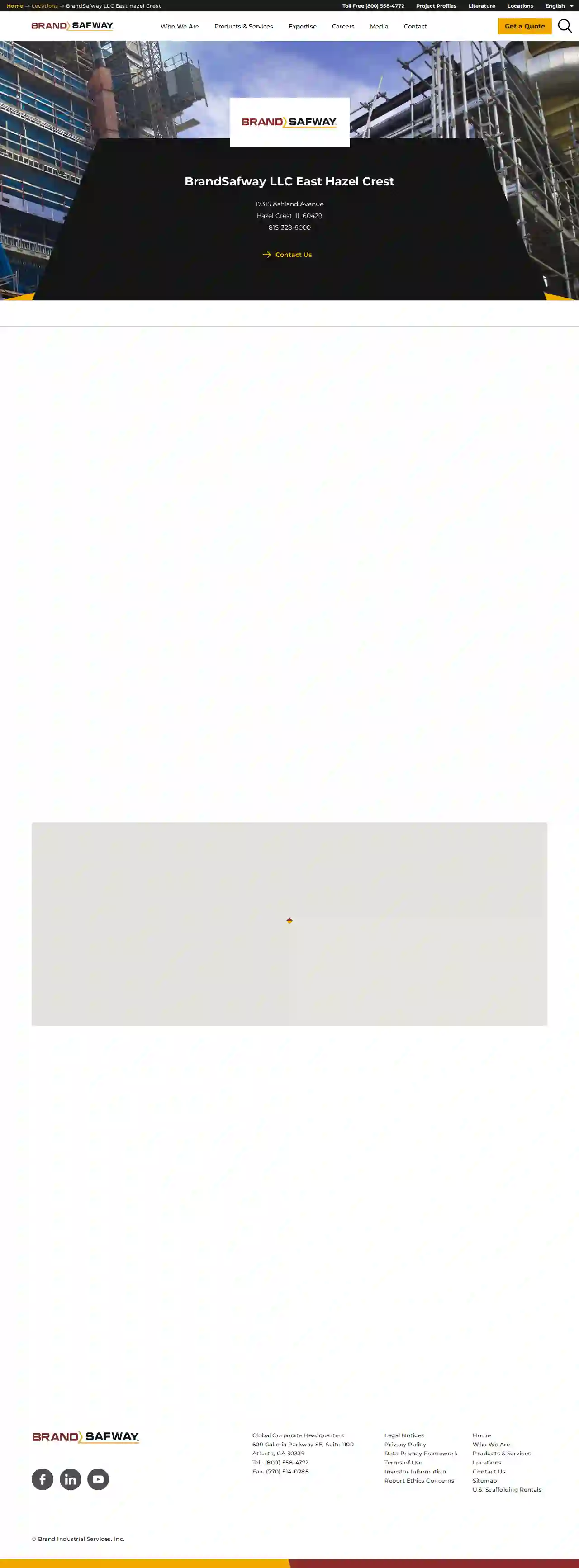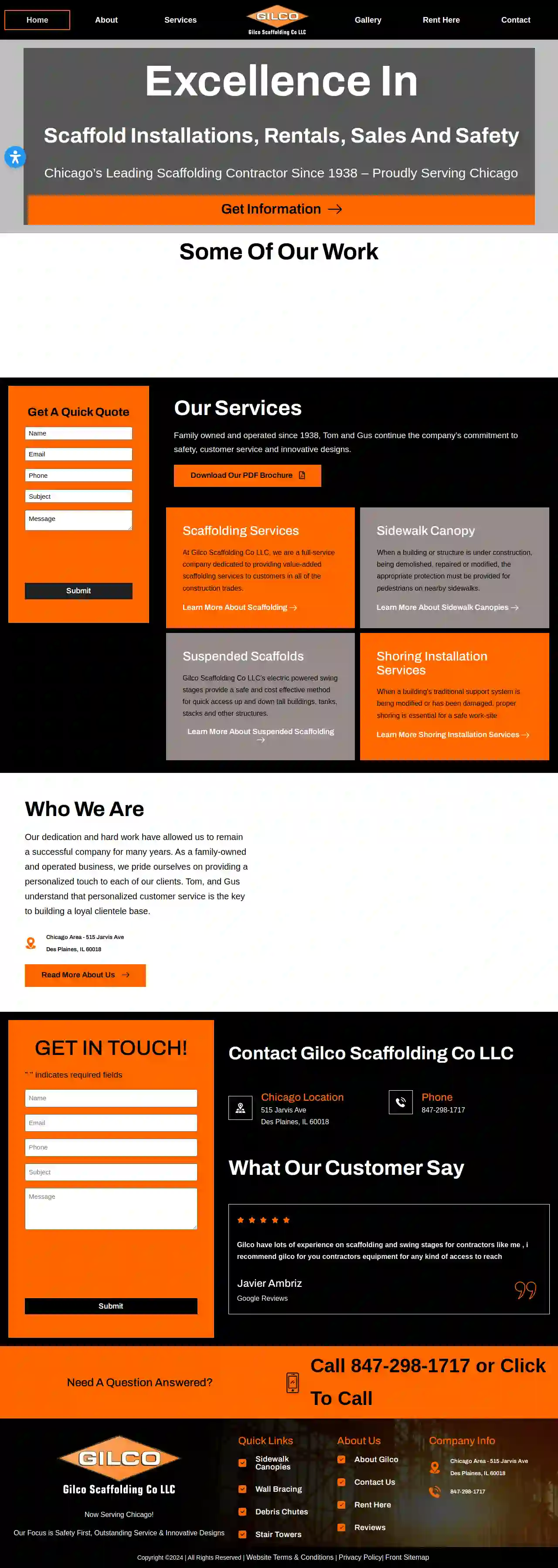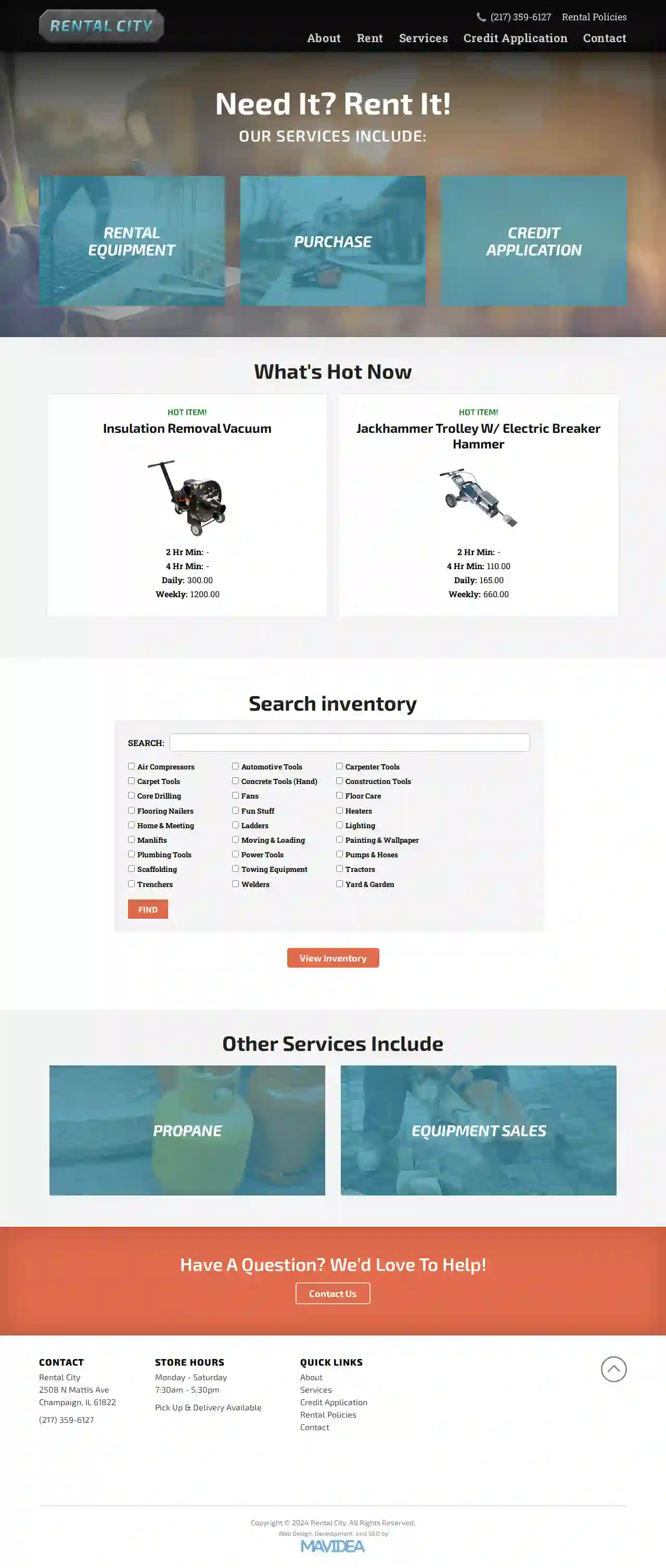Scaffolding Rental Calumet City
Top Scaffolding Rental in Calumet City
Receive 3 FREE Rent Scaffolding quotes for your project today! Compare profiles, reviews, accreditations, portfolio, etc... and choose the best deal.

Prime Scaffold Inc
4.19 reviews1220 North Ellis, Bensenville, 60106, USPrime Scaffold has been planning, designing, engineering and installing scaffolding systems in the Chicago metropolitan area for over 35 years. With a team of fully engaged and well-trained installers, they provide innovation, attention to detail, safety and excellent customer service. Their expertise meets specific project needs, working on large and small projects for local buildings, museums, airports, ballparks, skyscrapers and famous landmarks. They are OSHA compliant and have experience with complex projects such as the Garfield Park Conservatory and 401 North Michigan Avenue.
- Services
- Why Us?
- Gallery
Get Quote
Chicago Scaffolding Inc.
4.331 reviewsChicago, Illinois, 4824 W. Lake Street, 60644, USChicago Scaffolding Inc. (CSI), family owned and operated since 1988, has a rich history of experience and a family tradition of hard work and dependability. CSI prides itself on the core belief of providing exceptional service, quality, and safety to all clients. With a strong commitment to long-term professional relationships, we prioritize 100% customer satisfaction.
- Services
- Why Us?
- Accreditations
- Our Team
- Testimonials
- Gallery
Get Quote
BrandSafway LLC East Hazel Crest
123 BrandSafway Blvd, East Hazelcrest, 12345, USBrandSafway is a leading provider of access solutions, including scaffolding, aerial work platforms, and forming and shoring equipment. With a strong commitment to safety, quality, and customer satisfaction, BrandSafway offers a wide range of services tailored to meet the unique needs of clients across various industries. Their team of experienced professionals is dedicated to delivering innovative solutions that enhance efficiency and productivity, ensuring successful project outcomes.
- Services
- Why Us?
- Accreditations
- Our Team
- Testimonials
Get Quote
Bracing Systems Construction Supplies and Equipment
4.329 reviewsHanover Park, 4N350 Old Gary Ave, 60133, USWe understand your challenge: To get all your equipment and supplies reliably and on time, while maintaining good profit margins. As your most reliable source of construction equipment and contractor supplies, Bracing Systems can supply your company with the products to get your job done right and under budget. Whether you are a general contractor, masonry contractor, concrete contractor or a contractor in another specialized trade, we stock it for customer pick up or can deliver it right to the job site. Our service department has a huge inventory of parts in stock to repair your Lull, Mustang, JLG, Pettibone, or Manitou Forklift, Essick Mixer, Hydro-Mobile Scaffolding, Stihl Power Equipment, Multiquip Compactors /Troweling Machines and many more brands of construction equipment. We offer convenient customer pick up at our 2 suburban locations or excellent on time delivery to your jobsite.
- Services
- Why Us?
- Gallery
Get Quote
Gilco Scaffolding Co
3.316 reviews515 Jarvis Ave, Des Plaines, 60018, USExcellence In Scaffold Installations, Rentals, Sales And Safety Chicago’s Leading Scaffolding Contractor Since 1938 – Proudly Serving Chicago Our Services Family owned and operated since 1938, Tom and Gus continue the company’s commitment to safety, customer service and innovative designs. Scaffolding Services At Gilco Scaffolding Co LLC, we are a full-service company dedicated to providing value-added scaffolding services to customers in all of the construction trades. Who we are Our dedication and hard work have allowed us to remain a successful company for many years. As a family-owned and operated business, we pride ourselves on providing a personalized touch to each of our clients. Tom, and Gus understand that personalized customer service is the key to building a loyal clientele base.
- Services
- Why Us?
- Gallery
Get Quote
MVC Painting
4.976 reviews800 E Northwest Hwy, Suite 750, 800 E Northwest Hwy Suite 750, Palatine, 60074, USWelcome to MVC Painting, a full-service painting company with over 15 years of experience in making our client's home improvement dreams become a reality. Our team of skilled professionals is dedicated to providing high-quality workmanship and customer service. We offer a wide range of services, including interior/exterior painting, drywall installation and repair, power washing, and more. With 100% customer satisfaction guaranteed, you can rely on us to get it right the first time. We have 5-star ratings from hundreds of customers just like you.
- Services
- Why Us?
- Gallery
Get Quote
Walmart Supercenter
3.92600 S Eastwood Dr, Woodstock, 60098, USWelcome to Walmart! Walmart is a leading retailer offering a wide variety of products and services to customers across the globe. We strive to provide our customers with the best possible shopping experience, offering competitive prices, a vast selection of merchandise, and convenient shopping options. Our mission is to help people save money and live better, and we are committed to providing our customers with the best possible value. At Walmart, we believe in the power of community and are dedicated to supporting the communities we serve. We are proud to be a part of the Woodstock, IL community and are committed to providing our customers with the best possible shopping experience.
- Services
- Why Us?
- Gallery
Get Quote
Thompson Rental Station, Inc.
4.583 reviews215 W. Irving Park Road, Bensenville, 60106, USThompson's Rental specializes in equipment and tool rentals, as well as equipment sales, serving Northeastern Illinois. With two rental store locations in Bensenville and Des Plaines, IL, they offer a wide selection of equipment rentals and sales, including excavators, skid steers, lifts, lawn and garden tools, generators, air compressors, and more. They also provide party rentals and used equipment for sale. Their commitment to customer satisfaction and quality equipment sets them apart.
- Services
- Why Us?
- Gallery
Get Quote
Menards
4.3Chicago, USMenards is a home improvement store that offers a wide range of products and services for homeowners, contractors, and DIY enthusiasts. With a long history of providing quality products and excellent customer service, Menards has become a trusted name in the industry.
- Services
- Why Us?
Get Quote
Rental City Inc
4.5109 reviews2508 N. Mattis Ave., Champaign, 61821, USWelcome to Rental City! When you need a project done right, quality tools can be just as important as the people using them. We know you have other choices for your equipment needs. What sets Rental City apart from others is our dedication to you, our customer, with spectacular customer service. With decades of experience and over 2,000 items available for short-term rental, Rental City is a family owned business dedicated to serving your needs; whether residential or corporate. Rental City began with Mac D. Drysdale’s commitment to providing the best possible equipment in impeccable condition to benefit the greater Champaign community over 60 years ago. Today, we strive to offer the best product catalog, most convenient solutions, and the most effective and pleasant customer service available. We look forward to the opportunity of serving your family or business, and are here to help you get the job done.
- Services
- Why Us?
- Gallery
Get Quote
Over 2,353+ Scaffolding Companies registered
Our scaffolding contractors operate in Calumet City & surroundings!
ScaffoldingHQ has curated and vetted Top Scaffolding Contractors in and around Calumet City. Find a top & trustworthy business today.
Frequently Asked Questions About Scaffolding Rental
- Save Time: Easily compare quotes from multiple reputable scaffolding rental companies in one place.
- Find Local Providers: Quickly locate scaffolding companies serving your area.
- Get Competitive Rates: Access a network of rental providers, allowing you to compare prices and find the best deal.
- Ensure Safety and Quality: We partner with companies that prioritize safety and adhere to industry standards.
- Access Expert Support: Our customer support team is here to assist you throughout the rental process.
- Type of Scaffolding: Tube and clamp, system scaffolding, mobile towers, and specialized systems have different rental rates.
- Scaffolding Size and Height: Larger and taller scaffolding structures require more materials, increasing the cost.
- Rental Duration: The length of the rental period will significantly affect the price.
- Location: Rental rates can vary by location due to differences in labor costs and demand.
- Delivery and Setup: Some companies charge extra for delivery, erection, and dismantling services.
- Construction: Building new structures, adding extensions, and performing facade work.
- Renovation and Repair: Repairing or replacing roofs, siding, windows, and gutters.
- Maintenance: Cleaning windows, painting, and performing general upkeep on buildings.
- Industrial Work: Accessing elevated equipment, performing inspections and repairs on industrial structures, and carrying out construction work in industrial settings.
- Events: Creating temporary stages, grandstands, and platforms for concerts, festivals, and sporting events.
- Daily: For short-term tasks or smaller projects.
- Weekly: A common option for projects lasting a few days to a week.
- Monthly: Suitable for larger or longer-term projects.
- Custom Duration: Some companies may offer custom rental periods to fit your specific timeframe.
What are the benefits of using a scaffolding directory like ScaffoldingHQ?
How much does it cost to rent scaffolding?
What is scaffolding used for?
How long can you rent scaffolding for?
What are the benefits of using a scaffolding directory like ScaffoldingHQ?
- Save Time: Easily compare quotes from multiple reputable scaffolding rental companies in one place.
- Find Local Providers: Quickly locate scaffolding companies serving your area.
- Get Competitive Rates: Access a network of rental providers, allowing you to compare prices and find the best deal.
- Ensure Safety and Quality: We partner with companies that prioritize safety and adhere to industry standards.
- Access Expert Support: Our customer support team is here to assist you throughout the rental process.
How much does it cost to rent scaffolding?
- Type of Scaffolding: Tube and clamp, system scaffolding, mobile towers, and specialized systems have different rental rates.
- Scaffolding Size and Height: Larger and taller scaffolding structures require more materials, increasing the cost.
- Rental Duration: The length of the rental period will significantly affect the price.
- Location: Rental rates can vary by location due to differences in labor costs and demand.
- Delivery and Setup: Some companies charge extra for delivery, erection, and dismantling services.
What is scaffolding used for?
- Construction: Building new structures, adding extensions, and performing facade work.
- Renovation and Repair: Repairing or replacing roofs, siding, windows, and gutters.
- Maintenance: Cleaning windows, painting, and performing general upkeep on buildings.
- Industrial Work: Accessing elevated equipment, performing inspections and repairs on industrial structures, and carrying out construction work in industrial settings.
- Events: Creating temporary stages, grandstands, and platforms for concerts, festivals, and sporting events.
How long can you rent scaffolding for?
- Daily: For short-term tasks or smaller projects.
- Weekly: A common option for projects lasting a few days to a week.
- Monthly: Suitable for larger or longer-term projects.
- Custom Duration: Some companies may offer custom rental periods to fit your specific timeframe.